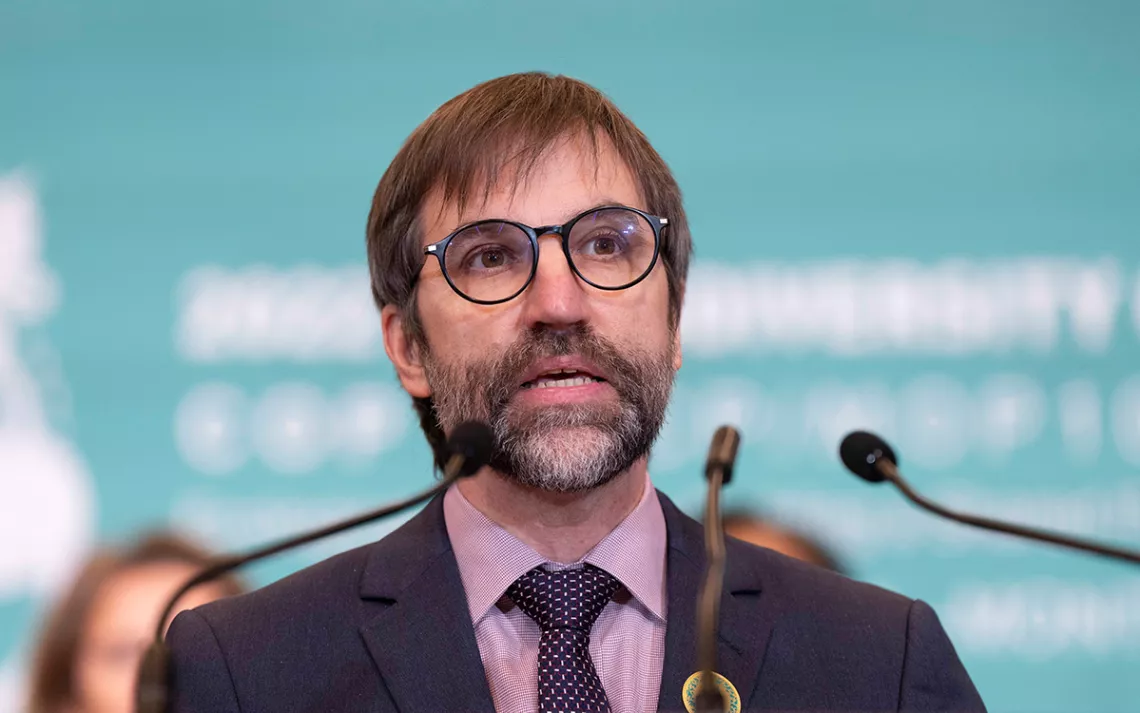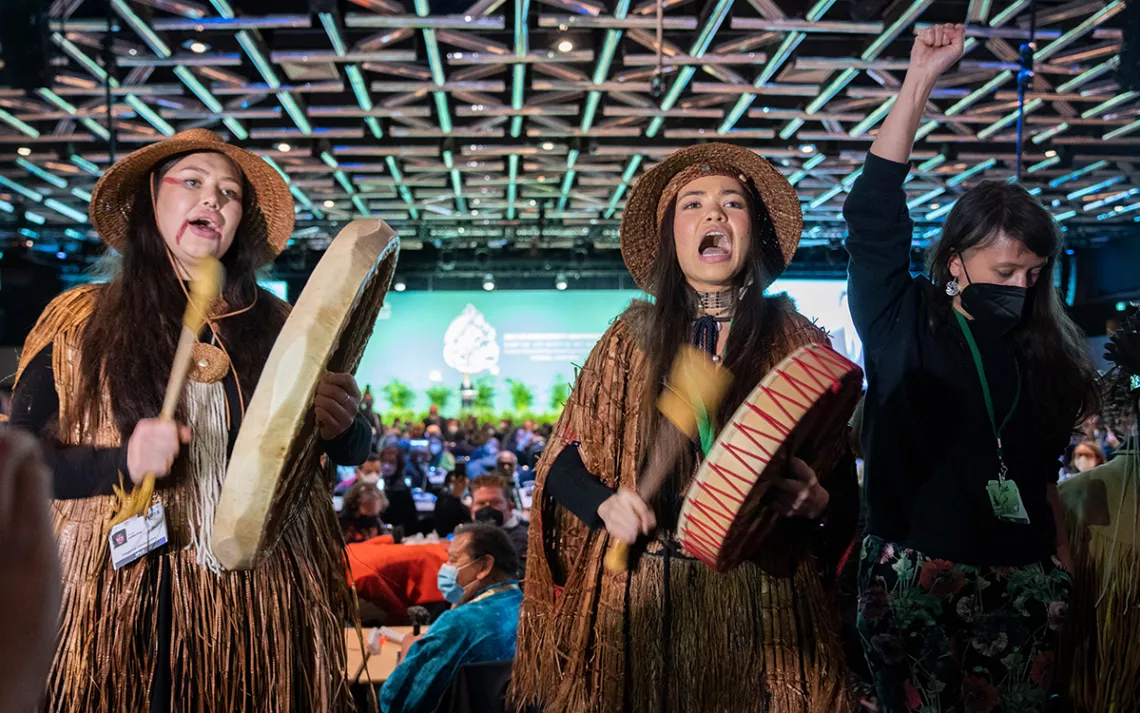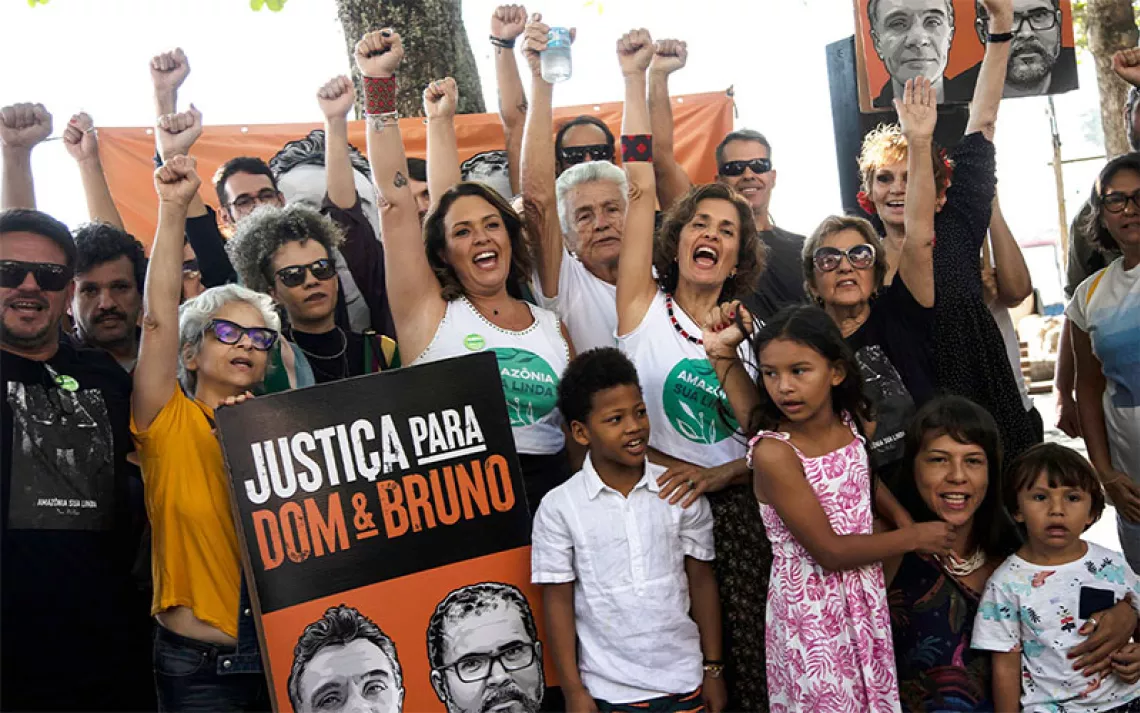How to Become an Ally for Indigenous-Led Conservation
Canada is showcasing how important Indigenous-led efforts are to meeting conservation goals

Canada environment minister Steven Guilbeault addresses a news conference at the COP15 UN conference on biodiversity in Montreal on December 16. | Photo by Paul Chiasson/The Canadian Press via AP
Iconic wild places in North America, like Yellowstone in the United States and Banff in Canada, make up a small percentage of land area. But it’s critical that we protect these wild places to prevent species decline. Wildlife need connections, and they need corridors to thrive.
Enter Indigenous-led conservation, a priority of the new Global Biodiversity Framework forged in Montreal. Canada’s prime minister, Justin Trudeau, conveyed its importance for his country at the beginning of the summit when he announced C$800 million over the next seven years for Indigenous conservation projects, and the minister of environment and climate change, Steven Guilbeault, met with tribal members to designate new Indigenous Protected and Conserved Areas throughout the country.
Valérie Courtois, the director of the Indigenous Leadership Initiative, a Canadian-based organization that supports Indigenous nationhood, also announced the launch of the National Guardian's Network. The initiative, which will ensure funding and support, is a collaboration between tribal citizens who steward and monitor their respective territories and the Canadian government. “We can only meet our international climate and biodiversity targets through strong partnerships with Indigenous people and the support of indigenous-led conservation,” said Guilbeault in a press statement.
The science supports Indigenous-led conservation initiatives. While Indigenous lands make up about 20 percent of Earth’s surface, about 80 percent of remaining biodiversity lies within Indigenous jurisdictions. Other reports from the United Nations also show that wildlife richness and species density tends to be higher on lands and waters managed by Indigenous communities.
Nearly every aspect of the Global Biodiversity Framework acknowledges the inherent rights of Indigenous people to the land, especially when it comes to protecting wildlife habitat. And the Declaration on the Rights of Indigenous Peoples, which is another United Nations framework, is used as a guiding principle. Among its main tenets is the “free, prior, and informed consent” of local communities when it comes to stewardship, resources, and conservation management. And for Indigenous communities, this is long overdue.

Protesters interrupt a speech by Canada prime minister Justin Trudeau during the opening ceremony of COP15, the UN Biodiversity Conference in Montreal. | Photo by Paul Chiasson/The Canadian Press via AP
“The Indigenous movement of conservation in Canada is not new,” said Courtois. “In fact, every single one of our rights assertions has revolved around the expression of our responsibilities and love for our lands. In the last 20 years … well over 90 percent of all established protected areas have been either led or co-led by Indigenous peoples.”
Canada has rapidly adopted Indigenous Protected and Conserved Areas to help achieve its aim to protect 25 percent of lands and waters by 2025, per its 2010 Aichi Target goals. And with this model, the goal of protecting 30 percent of lands and waters by 2030 is well within reach. With the quick adoption and success of Indigenous communities, Canada has become one of the leading examples of what nation-to-nation partnership looks like for land protection. In the last five years leading up to December’s biodiversity summit, three new Indigenous Protected and Conserved Areas were established in the Northwest Territories, covering over 9 million acres, over four times the size of Yellowstone.
During the 15th Conference of Parties negotiations, Canadian politicians held several side events, one with Stephanie Thorassie, the executive director of the Seal River Watershed Alliance, an advocacy group led by the Sayisi Dene First Nation, to announce the first steps toward designating a portion of the watershed as an IPCA. If created, the area, which is approximately the size of Costa Rica, would be one of the largest IPCAs in Canada. “Recognizing and respecting Indigenous decision-making on the land is essential for our shared future,” said Thorassie, who is from the Sayisi Dene First Nation, during the press event. “The four First Nations of the Seal River Watershed are offering a gift to the world, the gift of sustaining one of the largest intact watersheds left on the planet.”
Following that announcement, Guilbeault announced another first, the Canada–Yukon Nature Agreement, which grants the territory C$20.6 million to invest in Indigenous-led conservation. The funds will be used for habitat conservation and protection of at-risk species like mountain caribou and grizzly bears. And two days before the conference ended, he signed a letter of intent with the Dene tribal government and the government of the Northwest Territories to create another protected area called the Sahtuì K’aowe IPCA around Great Bear Lake. The lake is the largest solely contained within Canada’s borders and has been a vital part of the Dene First Nations community for thousands of years.
“Our people called Great Bear Lake Tsá Tué. It’s the eighth-largest freshwater lake in the world, and it is the most intact,” said Danny Gaudet, chief of Délı̨nę of the Dene First Nations People, during the signing of the letter. “Our people have kept it that way for many generations. We believe that we have the responsibility to keep it that way for the future generations yet to come.”
While many of the new agreements and funding sources were applauded by tribes and conservation groups, the new framework is not without its critics. One point that both members of tribal nations and NGOs have tried to emphasize is the need for ecological integrity, or the ability of ecosystems to support a diverse assemblage of species and systems. Some also say that countries should resist the urge to create paper parks, where areas are protected in name only. This is especially true when conservation or Indigenous communities collide with energy use.
“Canada has had an image on the world stage of being an environmental leader, of being a leader on Indigenous issues,” said Conor Curtis from the Sierra Club Canada. “It is one of those things where often what we find is when Indigenous rights go against an energy project, like Line 5, for instance ... the government has completely ignored those voices.”
 The Magazine of The Sierra Club
The Magazine of The Sierra Club



